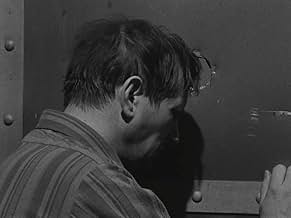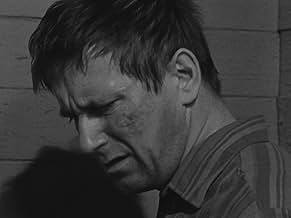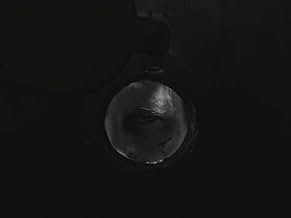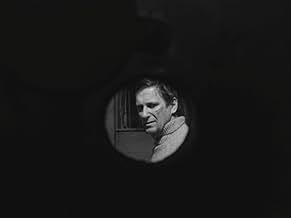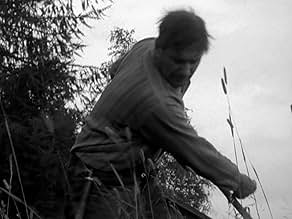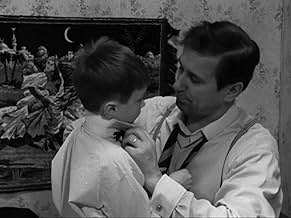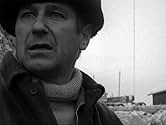Kahdeksan surmanluotia
- Mini-série télévisée
- 1972
- 5h 16m
ÉVALUATION IMDb
8,3/10
1,1 k
MA NOTE
Ajouter une intrigue dans votre languePasi shoots four policemen for drunkenness, leading to poverty, trouble with authorities, and family arguments. The movie is a flashback examining the events leading to the tragic shooting.Pasi shoots four policemen for drunkenness, leading to poverty, trouble with authorities, and family arguments. The movie is a flashback examining the events leading to the tragic shooting.Pasi shoots four policemen for drunkenness, leading to poverty, trouble with authorities, and family arguments. The movie is a flashback examining the events leading to the tragic shooting.
- Prix
- 2 victoires au total
Parcourir les épisodes
Histoire
Le saviez-vous
- AnecdotesBased on a true story: a small-farmer Tauno Pasanen (b. 1934) shot and killed four police officers who were coming to arrest him in 1969.
- Autres versionsFor the theatrical release in autumn 1972 was cut to 145 minute length.
- ConnexionsFeatured in Mikko & Ridge (1994)
Commentaire en vedette
This 1972 black and white mini-series directed by and starring Mikiko Niskanen, which consists of four hour-plus episodes, has been called the crowning achievement of Finnish cinema, even by Aki Kaurismäki. Why? It's showing in various film festivals lately (2013), including Rotterdam, Seattle, and San Francisco, so a wider international audience can find out. Eight Deadly Shots turns out to be a seamless and immersive narrative of alcoholism, rural poverty, and the romance of moonshine. Niskaken begins with a true event, not graphically illustrated, however: a habitual drunk, Pasi (Niskanen) kills four policemen after terrifying his family. What follow are scenes from a marriage and a life as the fimlmaker imagines them leading up to these killings. The use of non-actors, the humanistic directness, remind one of the Italian neorealists; visually sometimes, with the use of closeups, Eisenstein and the great silents come to mind. The "potential for intimacy" of Academy ratio helps that emphasis on faces and individuals -- though ensemble scenes of a prayer meeting and a wedding make several of the most memorable set pieces. In other aspects of technique there are doubtless much more contemporary influences too. It's an intimate epic, a universal tragedy with pointed Nordic relevance. This is an unmistakable classic and deserves to be on a US Criterion DVD.
Pasi is an alcoholic. It's a social disease and he draws others in with him, notably his cohort and drinking partner Reiska (Paavo Pentikäinen), with whom he secretly makes moonshine white lightening in one of the first prolonged sequences. Pasi has a small farm and they pretend to be working in a field, bury the still in the ground and cover it with hay. One sees the fascination of illegal enterprise feeding their favorite pastime of drinking, which must work similarly for pot growers in the American Northwest. When Pasi hands over his concealed bottle of moonshine to other men at social events, it's like he's proselytizing, and they're also sharing an activity that's more fun because it's forbidden, illegal. The secret sharers often smile and giggle and can't resist another shot and then another.
And then comes the erosion of the family. Pasi has a wife, Vaimo (Tarja-Tuuliki Tarsala) and four kids, three boys and a girl, strong presences in the film, and the family's passive suffering slowly grows from his disappearances, his hangovers, his incoherence or distractedness, all this worsened by the rural poverty of their situation, a farm that can't support them, odd jobs (extensively shown) that wouldn't suffice either, even if the drinking didn't erode the performance. And then come the scenes, particularly surrounding the prayer meeting and the wedding, when the family is shamed, disappointed and humiliated, all sense of security and safety shattered, and Pasi's wife bitterly rebukes him, to no effect. Some time past midway through the second episode Pasi becomes quite clearly frightening to his family. "You always scare me when you're drunk," his older son says. He works very hard through the winter (the early moonshine-making was in the summer): rolling big logs into the river, digging deep trenches for sewers, cutting down trees and splitting logs, then hauling them through the snow with his horse, Liisa. Poor Liisa! This log-hauling sequence in particular is gruelingly real, remarkable filmmaking. The work is all seasonal: in the spring comes fishing, planting, and moving the logs stacked in winter down to the river. Everything about all this shows direct knowledge of the life, passionate commitment by Niskanen and everybody involved, and remarkable use of non-actors. One can't help wondering if some of them weren't really drunk when they were filmed in the many boozing sequences. The camera-work is equally remarkable the way it follows the action and captures the beauty of the landscape and the seasons, and the editing maintains a steady hypnotic pace.
Niskanen knew whereof he spoke. He apparently came from poor, rural roots, and worked in forestry and as a car mechanic in his youth. "Everyone may have their own truth," he says in the opening statement repeated before each segment, "but this is the truth I have seen and experienced, having been born into these surroundings, having lived this particular life and having studied these matters." Niskanen is a magnetic personality, a force of nature, and also the most awarded filmmaker in Finnish history. Renowned Finnish writer-filmmaker Peter von Bagh made a three-part TV documentary about him, Director on the Way to Becoming a Human Being: Mikko Niskanen's story, which reviews his acclaimed oeuvre. The actual man who shot the police, Tauno Pasanen, went to jail in 1969, and was pardoned by the president in 1982, probably moved by the film's assertion of social causes. Fourteen years later, still a drunk, he strangled and killed his long-suffering wife, who had moved to be near him during his incarceration, but from whom he had been divorced. This time he served 13 years and was let out on parole.
Kahdeksan surmanluotia (Finnish title), 316 mins., released in 1972, won Best Actor and Best Director Jussi awards. Screened for the review in the four-part version as part of the San Francisco International Film Festival, May 2013.
Pasi is an alcoholic. It's a social disease and he draws others in with him, notably his cohort and drinking partner Reiska (Paavo Pentikäinen), with whom he secretly makes moonshine white lightening in one of the first prolonged sequences. Pasi has a small farm and they pretend to be working in a field, bury the still in the ground and cover it with hay. One sees the fascination of illegal enterprise feeding their favorite pastime of drinking, which must work similarly for pot growers in the American Northwest. When Pasi hands over his concealed bottle of moonshine to other men at social events, it's like he's proselytizing, and they're also sharing an activity that's more fun because it's forbidden, illegal. The secret sharers often smile and giggle and can't resist another shot and then another.
And then comes the erosion of the family. Pasi has a wife, Vaimo (Tarja-Tuuliki Tarsala) and four kids, three boys and a girl, strong presences in the film, and the family's passive suffering slowly grows from his disappearances, his hangovers, his incoherence or distractedness, all this worsened by the rural poverty of their situation, a farm that can't support them, odd jobs (extensively shown) that wouldn't suffice either, even if the drinking didn't erode the performance. And then come the scenes, particularly surrounding the prayer meeting and the wedding, when the family is shamed, disappointed and humiliated, all sense of security and safety shattered, and Pasi's wife bitterly rebukes him, to no effect. Some time past midway through the second episode Pasi becomes quite clearly frightening to his family. "You always scare me when you're drunk," his older son says. He works very hard through the winter (the early moonshine-making was in the summer): rolling big logs into the river, digging deep trenches for sewers, cutting down trees and splitting logs, then hauling them through the snow with his horse, Liisa. Poor Liisa! This log-hauling sequence in particular is gruelingly real, remarkable filmmaking. The work is all seasonal: in the spring comes fishing, planting, and moving the logs stacked in winter down to the river. Everything about all this shows direct knowledge of the life, passionate commitment by Niskanen and everybody involved, and remarkable use of non-actors. One can't help wondering if some of them weren't really drunk when they were filmed in the many boozing sequences. The camera-work is equally remarkable the way it follows the action and captures the beauty of the landscape and the seasons, and the editing maintains a steady hypnotic pace.
Niskanen knew whereof he spoke. He apparently came from poor, rural roots, and worked in forestry and as a car mechanic in his youth. "Everyone may have their own truth," he says in the opening statement repeated before each segment, "but this is the truth I have seen and experienced, having been born into these surroundings, having lived this particular life and having studied these matters." Niskanen is a magnetic personality, a force of nature, and also the most awarded filmmaker in Finnish history. Renowned Finnish writer-filmmaker Peter von Bagh made a three-part TV documentary about him, Director on the Way to Becoming a Human Being: Mikko Niskanen's story, which reviews his acclaimed oeuvre. The actual man who shot the police, Tauno Pasanen, went to jail in 1969, and was pardoned by the president in 1982, probably moved by the film's assertion of social causes. Fourteen years later, still a drunk, he strangled and killed his long-suffering wife, who had moved to be near him during his incarceration, but from whom he had been divorced. This time he served 13 years and was let out on parole.
Kahdeksan surmanluotia (Finnish title), 316 mins., released in 1972, won Best Actor and Best Director Jussi awards. Screened for the review in the four-part version as part of the San Francisco International Film Festival, May 2013.
- Chris Knipp
- 8 avr. 2013
- Lien permanent
Meilleurs choix
Connectez-vous pour évaluer et surveiller les recommandations personnalisées
- How many seasons does Eight Fatal Shots have?Propulsé par Alexa
Détails
- Durée5 heures 16 minutes
- Couleur
- Mixage
- Rapport de forme
- 1.33 : 1
Contribuer à cette page
Suggérer une modification ou ajouter du contenu manquant

Lacune principale
By what name was Kahdeksan surmanluotia (1972) officially released in Canada in English?
Répondre
